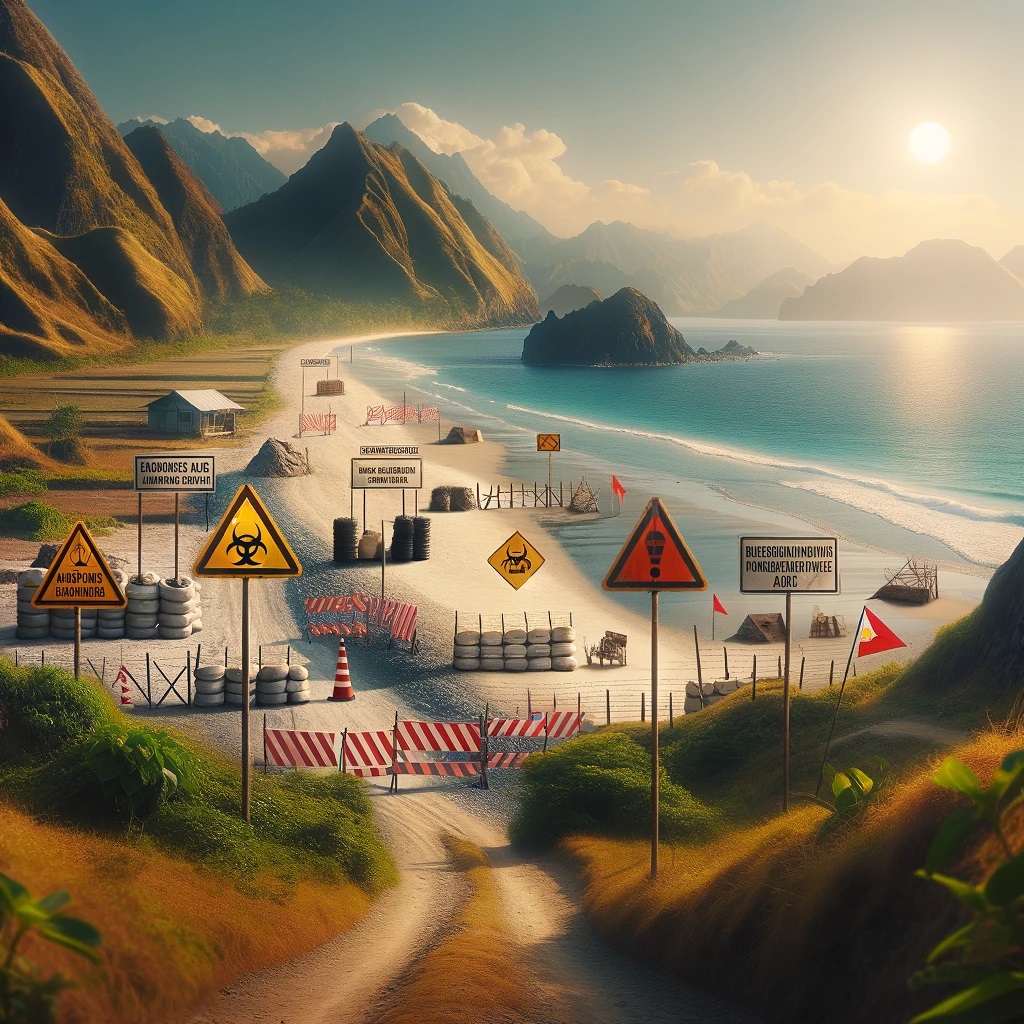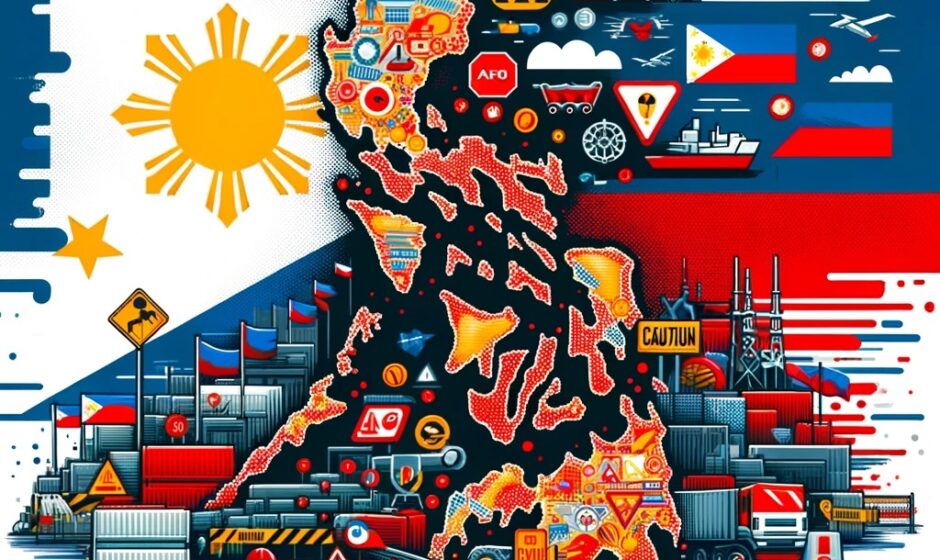“Danger Zones To Avoid In The Philippines” is a crucial guide for anyone venturing into this beautiful archipelago. The Philippines, known for its stunning beaches and vibrant culture, also has areas that pose risks. Recognizing these danger zones ensures a safe and enjoyable experience. As an expert with firsthand knowledge, I’ll share insights to keep you informed and secure.
Firstly, it’s vital to be aware of certain regions experiencing unrest. Parts of Mindanao, for example, face challenges due to insurgent activities. These areas can be unpredictable and unsafe for travelers. Hence, it’s best to stay updated with current travel advisories.
Another key point involves natural hazards. The Philippines is prone to typhoons and volcanic activities. Certain areas, like those near active volcanoes, require extra caution. Always check weather forecasts and heed local advisories.
Urban areas, while bustling with life, have their risks too. Petty crimes, such as pickpocketing and scams, are common in crowded places. Always safeguard your belongings and be wary of too-good-to-be-true offers. In Manila, avoid notorious neighborhoods known for high crime rates.
When it comes to beaches and marine activities, don’t underestimate the power of nature. Strong currents and riptides can be dangerous even for experienced swimmers. Always swim in designated areas and follow lifeguard instructions. Be mindful of marine life, too. Some species, like jellyfish, can pose risks.
Lastly, let’s talk about roads. Traffic in the Philippines can be chaotic. Avoid driving if you’re not accustomed to local road conditions. Use reputable transportation services instead.

Parts of Mindanao
When exploring the Philippines, it’s essential to understand “Danger Zones To Avoid In The Philippines,” particularly in parts of Mindanao. Mindanao, a region known for its diverse culture and breathtaking landscapes, also harbors areas of conflict and unrest. Therefore, travelers need to exercise caution. Specifically, the Sulu Archipelago, including the provinces of Basilan, Sulu, and Tawi-Tawi, often faces security challenges. Additionally, the Zamboanga Peninsula, a region with a rich history, occasionally experiences unrest. Avoid these areas due to potential risks of kidnapping and militant activities.
Moreover, certain parts of Central Mindanao, including the provinces of Cotabato and South Cotabato, have witnessed sporadic clashes. These conflicts can erupt without warning, posing risks to safety. Furthermore, the eastern parts of Mindanao, despite their natural beauty, occasionally experience environmental hazards like typhoons and floods. Stay updated with local news and travel advisories.
However, it’s not all cautionary tales. Many areas in Mindanao are peaceful and welcoming, showcasing the Philippines’ incredible diversity and hospitality. Engage with local communities and learn about their cultures. By being aware and making informed choices, travelers can experience the beauty of Mindanao safely and responsibly. Remember, information and awareness are your best tools for a safe journey.
Metro Manila’s High-Crime Areas
Navigating “Danger Zones To Avoid In The Philippines” is crucial, especially in Metro Manila’s high-crime areas. Metro Manila, the bustling capital region of the Philippines, offers a vibrant mix of culture and history. Yet, it’s wise to be cautious in certain areas. Notably, parts of Quiapo, known for its market and historic church, can be risky. Petty theft and scams are common, particularly in crowded areas. Similarly, Tondo, despite its strong community spirit, has neighborhoods with higher crime rates. Avoid less populated streets here, especially at night.
Furthermore, areas like Ermita and Malate, while popular for nightlife, require extra vigilance. Pickpocketing and tourist-targeted scams are not uncommon. Always keep your belongings secure and stay in well-lit, populated areas. Additionally, Pasay City, adjacent to the airport, has spots prone to theft and fraud. Be wary of overly friendly strangers or unofficial taxis.
However, Manila also offers safe and enjoyable experiences. Engage with local culture, try Filipino cuisine, and explore historic sites. Just stay informed, use reputable transportation, and trust your instincts. By being alert and informed, you can enjoy Metro Manila’s diverse offerings while staying safe. Remember, awareness is your best safety tool in any big city.
Areas Prone to Natural Disasters
In the Philippines, natural disaster danger zones are crucial to identify. Firstly, the country sits on the Pacific “Ring of Fire”. Consequently, earthquakes and volcanic eruptions are common. Travelers must avoid areas near active volcanoes, such as Mount Mayon and Taal. Moreover, the Philippines faces an annual onslaught of typhoons. Specifically, regions like Eastern Visayas and Bicol are at high risk. Here, typhoons bring devastating winds and floods. Importantly, these natural disasters can occur with little warning. Hence, staying informed is critical. Additionally, low-lying coastal areas are prone to tsunamis and storm surges. These places, particularly along the eastern coast, demand extra caution.
Furthermore, landslides are a threat in mountainous regions. Notably, during the rainy season, these areas become particularly dangerous. Thus, avoiding travel there during this period is wise. Lastly, urban areas are not immune to these risks. In fact, Manila experiences flooding and infrastructure damage during severe weather. Clearly, awareness of these danger zones is key to safe travel in the Philippines. Therefore, travelers should always consult updated advisories before planning their journey. This approach ensures not only safety but also a more enjoyable experience. Remember, preparedness is your best defense in these natural disaster-prone areas.
Jolo Province
Understanding “Danger Zones To Avoid In The Philippines” is crucial, particularly in Jolo Province. Jolo, part of the Sulu Archipelago, is known for its natural beauty and rich cultural heritage. However, it’s also one of the areas in the Philippines where travelers must exercise utmost caution. The province has been troubled by insurgency and conflicts, making it less safe for tourists and even locals. Kidnappings and militant activities are significant concerns here.
Therefore, it’s essential to prioritize safety over adventure in this region. Avoid travel to Jolo unless absolutely necessary. If travel is unavoidable, always coordinate with local authorities and security personnel. Stick to well-known areas and avoid exploring isolated locations. Also, be aware of the local customs and religious practices, as Jolo has a predominantly Muslim population.
Moreover, stay updated with travel advisories from reputable sources. They provide valuable, up-to-date information on safety and security in the region. Additionally, consider alternative destinations within the Philippines that offer similar natural and cultural experiences but with a higher safety profile.
Quezon City
In discussing “Danger Zones To Avoid In The Philippines,” it’s vital to mention certain areas in Quezon City. As one of Metro Manila’s largest and most vibrant cities, Quezon City is a hub of culture, education, and government. However, like any big city, it has areas where caution is advised. Payatas, known for its large landfill, has neighborhoods that can be unsafe due to poverty and crime. It’s wise to avoid these areas, especially at night.
Another area to be cautious in is certain parts of Novaliches. While it has charming residential areas, some zones are known for higher crime rates. Travelers should be vigilant, avoid less frequented streets, and keep their belongings secure. Similarly, areas around Balintawak market, though bustling and lively, can be prone to petty crimes like pickpocketing.
Despite these concerns, Quezon City offers many safe and exciting attractions. Explore its renowned restaurants, parks, and cultural centers. Always use reputable transportation services and stay in well-known, safer areas. Being aware and informed is key to enjoying all that Quezon City has to offer. Remember, a cautious approach enhances your travel experience, allowing you to explore safely and confidently.
Sulu Archipelago
When discussing “Danger Zones To Avoid In The Philippines,” the Sulu Archipelago demands attention. This group of islands, steeped in rich history and cultural diversity, also faces significant security challenges. Notably, areas like Jolo, Basilan, and Tawi-Tawi, despite their natural beauty, are often associated with safety risks. These include insurgent activities and piracy, which pose threats to both locals and visitors.
Therefore, travelers should exercise extreme caution or avoid these areas altogether. Staying informed about current events and travel advisories is crucial. These resources offer real-time updates on safety conditions. For essential travel to these islands, coordinating with local authorities and security forces is a must. They provide invaluable guidance and assistance in navigating these regions.
Moreover, it’s important to understand the cultural and religious dynamics of the Sulu Archipelago. It has a predominantly Muslim population with unique customs and practices. Respecting these local traditions is vital for a harmonious visit.
While the allure of undiscovered beaches and rich cultural heritage is tempting, safety must remain a priority. There are numerous other destinations within the Philippines that offer similar experiences with a higher safety profile. Remember, being well-prepared and informed is key to a safe and enjoyable travel experience in the Philippines.
Is it safe to visit the Philippines?
Navigating “Danger Zones To Avoid In The Philippines” is a critical aspect of planning your trip to this magnificent country. While it’s important to be aware of “things prohibited in Philippines” and “What Not to Do in Philippines,” it’s equally essential to recognize the vast, safe, and welcoming parts of this archipelago. The Philippines is a land of unparalleled beauty, brimming with friendly locals, stunning landscapes, and rich cultural heritage.
Embracing local customs, enjoying the diverse cuisine, and exploring the breathtaking natural sights are just a few of the countless joys of visiting the Philippines. From the rice terraces of Banaue to the pristine beaches of Palawan, the country offers safe and memorable experiences. Engaging with the vibrant city life of Manila and Cebu introduces you to the heart of Filipino hospitality.
It’s all about informed travel choices. Stay updated with current advisories, respect local laws and customs, and prioritize safety. By doing so, you unlock the true potential of this beautiful nation. Remember, the Philippines is more than just its cautionary tales. It’s a country rich in experiences waiting to be discovered.
In conclusion, while mindful of “Danger Zones To Avoid In The Philippines,” don’t miss out on the safe, enriching, and authentic experiences this country offers. Each visit to the Philippines can be a journey of discovery, cultural immersion, and unforgettable memories. So pack your bags, keep these tips in mind, and embark on an adventure in one of Southeast Asia’s most enchanting countries.

